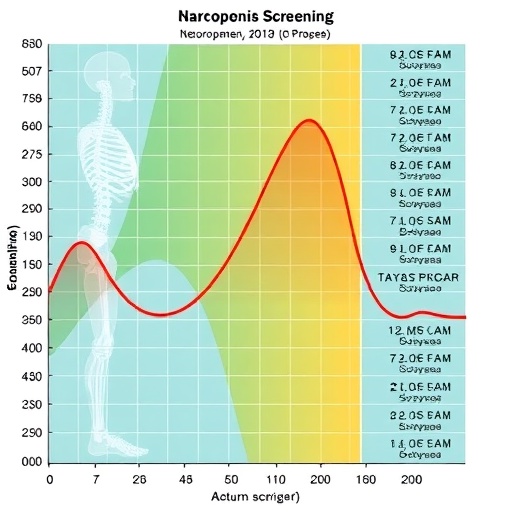In a groundbreaking study aimed at enhancing clinical decision-making in orthopedic care, researchers have meticulously developed and validated a nomogram designed for the screening of sarcopenia in patients afflicted with osteoporotic vertebral compression fractures. As the population ages, the prevalence of osteoporosis and its related complications, such as vertebral compression fractures, has escalated dramatically, leading to a pressing need for effective screening tools. Sarcopenia, which refers to the progressive loss of muscle mass and strength, can considerably complicate recovery and rehabilitation in these patients, necessitating the creation of a predictive model that is both reliable and user-friendly for clinicians.
The researchers employed a robust Bootstrap resampling method to carry out an internal validation of their nomogram. This involved a process where training set data was subjected to sampling with replacement, thereby creating multiple iterations of the dataset for performance assessment. They executed this resampling 1000 times—a substantial figure that ensures a comprehensive understanding of the model’s stability and reliability. The resulting Bootstrap-ROC curve provided critical insights into the model’s predictive prowess, revealing a remarkable C-index and AUC value of 0.863, with a 95% confidence interval ranging from 0.8121 to 0.9120.
This internal validation indicated a predictive capability that was slightly superior to that obtained from the training set, which exhibited an AUC of 0.859 (95% CI: 0.8103–0.9075). Such incremental improvements suggest that the model not only holds potential validity within the training context but also exhibits resilience and adaptability when confronted with varied patient data. These outcomes highlight the nomogram’s excellent predictive ability, reinforcing its promise as a valuable tool for clinicians dealing with the fragility and frailty characteristic of older populations with osteoporosis.
Following the internal validation, the researchers proceeded to perform a critical external validation, utilizing a dataset composed of 71 patients. This step was instrumental in gauging the model’s applicability to real-world clinical scenarios beyond the training environment. The ROC curve generated from the external validation set depicted an AUC of 0.811, indicating strong predictive performance, while the sensitivity and specificity rates of 0.676 and 0.892, respectively, illustrated the model’s relevant accuracy and reliability in predicting sarcopenia among patients.
Moreover, the statistical assessment through the Hosmer-Lemeshow test yielded an X² value of 11.06 with a P-value of 0.199, thereby suggesting that there were no statistically significant differences between the predicted probabilities produced by the nomogram and the actual observed outcomes. This finding signifies that the model fits well within the external validation context, offering assurance that it can withstand scrupulous examinations and provide credible results across diverse patient cohorts.
In addition to its fit and predictive strength, the calibration curves further reinforced the model’s integrity, yielding a Brier score of 0.176. This score signifies the model’s excellent agreement between predicted and actual results, representing a sound balance that is critical for effective clinical utility. Furthermore, the decision curve constructed from the external validation results presented a favorable clinical benefit, emphasizing that the nomogram can substantively aid in informed decision-making for healthcare providers when evaluating patients for sarcopenia.
As the healthcare community grapples with the pressing challenges posed by the aging population, especially in the context of osteoporosis, this research offers a beacon of hope. By providing a validated, user-friendly nomogram for sarcopenia screening, the study paves the way for enhanced patient management and tailored therapeutic strategies. Empowering clinicians with precise tools can potentially reshape recovery trajectories for patients, improving outcomes and reducing the burden on healthcare systems.
Furthermore, the importance of a well-validated model cannot be overstated. The researchers have furnished not merely a theoretical construct but a practical instrument that can be rapidly integrated into clinical practice. With appropriate training, clinicians can utilize the nomogram to effectively identify at-risk patients, enabling prompt interventions that may mitigate the detrimental consequences of sarcopenia on recovery from osteoporotic fractures.
Looking ahead, future studies may build upon this foundational work by exploring the integration of additional parameters or biomarkers that could further refine the model’s accuracy. Continuous iterations and validations across even larger datasets will be essential in solidifying its role in clinical pathways. Such advancements are crucial for ensuring that healthcare providers are equipped with the latest tools and methodologies that can directly impact patient care.
Lastly, dissemination of this research within the medical community will be critical for its uptake. As anecdotal experiences from early adopters of the nomogram emerge, sharing of best practices and clinical insights will be instrumental. Ultimately, the goal of this nomogram and accompanying research is to create a paradigm shift in how sarcopenia is identified and managed in patients dealing with the fragility of osteoporotic fractures, ensuring that no patient falls through the cracks in the healthcare system.
By leveraging innovative research and translating it into practice, clinicians can expect not just improvements in individual patient outcomes, but also broader impacts on population health as these tools are adopted widely. Emphasizing the transitional pathway from research to practice is key in overcoming the barriers that often hinder the implementation of promising medical innovations.
In conclusion, as this study illustrates, the convergence of research efforts, practical applications, and rigorous validations can yield transformative benefits in clinical care. It is imperative that the medical community embraces such advancements, ultimately striving towards a future where patients receive the utmost quality of care.
Subject of Research: Sarcopenia screening in patients with osteoporotic vertebral compression fractures
Article Title: Construction and validation of a nomogram for screening for sarcopenia in patients with osteoporotic vertebral compression fracture.
Article References:
Liao, Y., Fu, C. & Xing, S. Construction and validation of a nomogram for screening for sarcopenia in patients with osteoporotic vertebral compression fracture.
Sci Rep 15, 38525 (2025). https://doi.org/10.1038/s41598-025-17688-6
Image Credits: AI Generated
DOI: https://doi.org/10.1038/s41598-025-17688-6
Keywords: sarcopenia, osteoporosis, vertebral compression fractures, nomogram, predictive model, Bootstrap resampling, internal validation, external validation, ROC curve, clinical decision-making.




